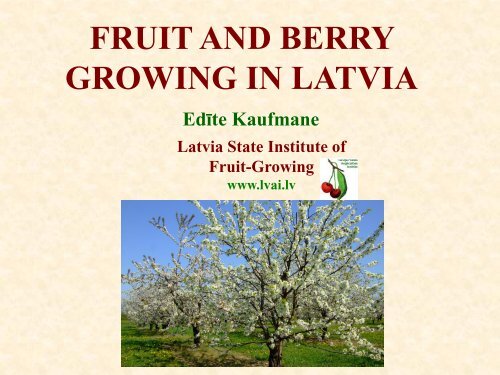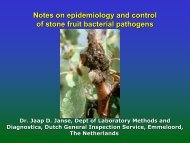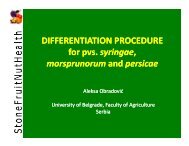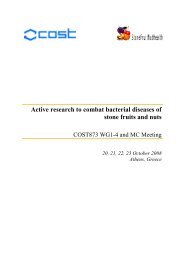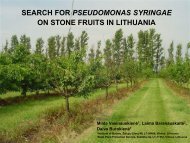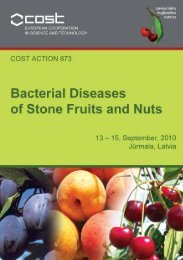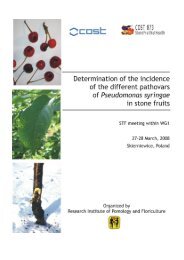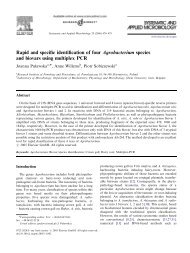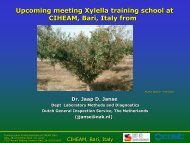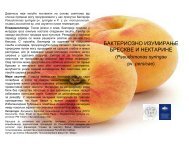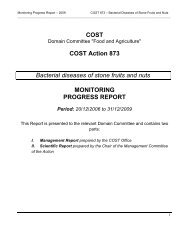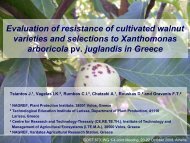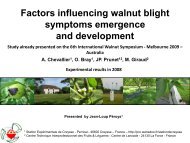Stone fruit production in Latvia - Cost 873
Stone fruit production in Latvia - Cost 873
Stone fruit production in Latvia - Cost 873
- No tags were found...
Create successful ePaper yourself
Turn your PDF publications into a flip-book with our unique Google optimized e-Paper software.
Fruit grow<strong>in</strong>g has old traditions <strong>in</strong> <strong>Latvia</strong>, and the climatic conditionsand soil are favorable for it, especially <strong>in</strong> the eastern regions of <strong>Latvia</strong>.Our <strong>fruit</strong>s and berries may conta<strong>in</strong> somewhat less sugar than thevarieties grown <strong>in</strong> the south, yet they have more aroma and organicacids, and significantly less pesticide spray<strong>in</strong>gs are needed for theirgrow<strong>in</strong>g.
History of <strong>fruit</strong> and berry grow<strong>in</strong>g <strong>in</strong> <strong>Latvia</strong>Before the 2nd World War, successful development began <strong>in</strong> <strong>fruit</strong> grow<strong>in</strong>g:<strong>fruit</strong> and berry export was started.Collectivization and nationalization of farms <strong>in</strong>terrupted this process. Largeextensive orchards were planted for the needs of the process<strong>in</strong>g <strong>in</strong>dustry, so theareas of orchards and brutto yield <strong>in</strong>creased rapidly at first. This process was spedup by the fast growth <strong>in</strong> the numbers of home garden owners. Yet the quality of<strong>production</strong> was lack<strong>in</strong>g.After the renewal of <strong>in</strong>dependence of <strong>Latvia</strong> <strong>in</strong> 1991, when the agriculturalreform was started, many large-sized orchards were split up and returned to theprevious landowners.A large number of rather small (10 to 20 hectares) farms were formed as aresult of the agricultural reform.Many have already recognized horticulture as one of the ways of successfuldevelopment.The importance of home garden<strong>in</strong>g is decreas<strong>in</strong>g. In fresh berry market,commercial <strong>production</strong> is already dom<strong>in</strong>at<strong>in</strong>g, while commercial <strong>production</strong> ofpome and stone <strong>fruit</strong>s still cannot meet the demand
On 2009 the data of <strong>Latvia</strong> Fruit-grower asociation show that<strong>in</strong>volved about 800 farms and use about 3000 ha <strong>in</strong> <strong>fruit</strong> <strong>in</strong>dustry9%9% 3% 3%42%12%22%1 to 3 ha 3 to5 ha 5 to 7 ha 7 to 10 ha10 to15 ha 15 to 20 ha >20 haBreakdown of farms by orchard areaAt present, small orchards (1 to 3 ha) are dom<strong>in</strong>at<strong>in</strong>g.Only 6 % are larger than 15 ha.
23514622296921applepearsour cherrysweet cherryplumblack currant96red and white currantraspberry6275741 92122seabuckhtornblueberrycranberryArea of new orchards<strong>in</strong> 1998 – 2007, haS<strong>in</strong>ce 1998, when subsidy payment started for orchardestablishment, the areas <strong>in</strong>creased by 2650 ha. Apples and blackcurrants were the most planted crops.
The structure of <strong>fruit</strong> <strong>production</strong>• Fresh <strong>fruit</strong>s and berries from commercial orchards for directconsum<strong>in</strong>g <strong>in</strong> time of season:amount: ~1500 t berries and ~1000 t <strong>fruit</strong>s;95 % - local market, 5 % - export• Fresh <strong>fruit</strong>s for long store (ma<strong>in</strong>ly desert apples):amount: ~3000 t <strong>fruit</strong>s; 95 % - local market, 5 % - export.• Fruits and berries for process<strong>in</strong>g :amount: ~1000 t berries and 5000 t <strong>fruit</strong>s; 70 % - export, 30 % -local process<strong>in</strong>g enterprises. Ma<strong>in</strong> products for export are frozenberries and juice, apples.
The ma<strong>in</strong> problems <strong>in</strong> the development of <strong>fruit</strong>grow<strong>in</strong>g <strong>in</strong> <strong>Latvia</strong>- Ties between the growers and the food processors, as well as between thegrowers and the market.- The <strong>Latvia</strong>n Fruit Growers' Association now works only as a publicorganization. Cooperatives are start<strong>in</strong>g to develop, but slowly. Some foodprocess<strong>in</strong>g plants have agreements with local growers, but others are import<strong>in</strong>graw material.- The quality of the product, especially of the tree <strong>fruit</strong>s, is not always highenough. To improve quality, horticultural knowledge <strong>in</strong> the field of high quality<strong>fruit</strong>s must be widely spread. The varietals structure must be changed also.- Lack of modern <strong>fruit</strong> storage and process<strong>in</strong>g facilities.- Risk-reduc<strong>in</strong>g grow<strong>in</strong>g technologies are not yet used enough.-The diversity of available means for plant protection is limited because of thesmall market.-<strong>Latvia</strong>n producers lack resources for long term <strong>in</strong>vestment.
Fruit grow<strong>in</strong>g has high potential <strong>in</strong> <strong>Latvia</strong>•Fruit grow<strong>in</strong>g has already taken a stable place <strong>in</strong> the agricultural<strong>production</strong> of <strong>Latvia</strong>.•In total 11 <strong>fruit</strong> crops are grown commercially, and their area has<strong>in</strong>creased for 2650 ha dur<strong>in</strong>g the last 10 years.•The <strong>production</strong> is diverse – fresh <strong>fruit</strong>s and berries, various processedproducts. So <strong>in</strong> comparison with other spheres of agriculture <strong>fruit</strong> grow<strong>in</strong>gis less dependent on the large process<strong>in</strong>g enterprises.•The <strong>in</strong>come per ha is high (<strong>in</strong>tensive orchards).•Orig<strong>in</strong>al processed products have a wide perspective, develop<strong>in</strong>gprocess<strong>in</strong>g at farms and small enterprises.•Market demand for local <strong>fruit</strong> <strong>production</strong> still is not satisfied.•Increas<strong>in</strong>g consumer preference for locally grown <strong>fruit</strong>s and theirproducts.
Fruit and berry process<strong>in</strong>g- The largest process<strong>in</strong>g enterprises which use also <strong>Latvia</strong>n-grown rawmaterial make juices or juice concentrates, additives to ice-cream andyoghurt.- The amount apples sold for process<strong>in</strong>g at present is decreas<strong>in</strong>g, because<strong>in</strong> the modern <strong>in</strong>tensive orchards it is more profitable to produce dessert<strong>fruit</strong>s.- Jo<strong>in</strong><strong>in</strong>g the EU stimulated the establish<strong>in</strong>g of small and home process<strong>in</strong>genterprises which use not only the traditional <strong>fruit</strong>s and berries, but alsonew crops with high nutritive value – seabuckthorn, Japanese qu<strong>in</strong>ce,cranberry.- At the moment there are about 30 such enterprises <strong>in</strong> <strong>Latvia</strong>, whoseactivities help to diversify the processed products <strong>in</strong> the market.
The total area of cherry plantations is about 890 ha, of these 90 ha of sour and41 ha of sweet cherries have been planted for market <strong>production</strong>, us<strong>in</strong>g subsidiesfor orchard establishment.At present, only one sour cherry variety isbe<strong>in</strong>g widely grown <strong>in</strong> <strong>Latvia</strong> - the local cultivar'Latvijas Zemais‘.Cherry plantations are established withmicropropagated plants, as well as trees budded onPrunus mahaleb seedl<strong>in</strong>gs and plants from selfrootedlayers.Better sour cherry varieties with firm <strong>fruit</strong> fleshand small stone are lack<strong>in</strong>g.
The growers have some <strong>in</strong>terest also <strong>in</strong> the plant<strong>in</strong>g of sweet cherry.The assortment is formed by Russian varieties - 'Iputj', 'BryanskayaRozovaya' and the Estonian 'Meelika' .The local cherries can not compete with theimported <strong>fruit</strong>s <strong>in</strong> size, yet the consumers value themfor their good flavour.Sweet cherries at present are grown on P.mahaleband P. avium seedl<strong>in</strong>g rootstocks.As there is a lack of w<strong>in</strong>ter-hardy cultivars withhigh quality <strong>fruit</strong>s, some work was done by sweetcherry breed<strong>in</strong>g.Serious damage dur<strong>in</strong>g the last years is caused bycherry fly.‘Iputj’
The total area of plum (mostly Prunus domestica) plantations is 980 ha, ofthese 57 ha have been planted for commercial <strong>production</strong> us<strong>in</strong>g subsidies fororchard establishment.• So far, Prunus cerasifera seedl<strong>in</strong>gs arebe<strong>in</strong>g used as rootstocks for plums.• Plums are grown mostly for the freshmarket, and for this reason the plantations areestablished with a number of varieties ripen<strong>in</strong>galong an extended period of time, to supply themarket as long as possible.‘Lāse’• The area of 6 most popular plum varieties is 69% of the total area. An extremely early matur<strong>in</strong>gdiploid variety is 'Kometa'. For commercialorchards, recommended varieties are also 'Victoria‘,‘Julius', 'Perdrigon', 'Stanley‘, M<strong>in</strong>jona’ and‘Lase’.• Recently, the Eurasia group of plums hasacquired <strong>in</strong>terest ('Aleynaya', 'ZarechnayaRannaya' etc.).‘Kometa’
Four new <strong>Latvia</strong>n plum and one – sweet cherry cultivarare prepared for the registration‘Paula’‘Lotte’‘Ance’‘Adele’‘Sonora’
<strong>Latvia</strong> State Institute ofFruit – Grow<strong>in</strong>gGraudu str.1, Dobele, LV 3701www.lvai.lv
General <strong>in</strong>formationThe <strong>Latvia</strong> State Institute of Fruit-Grow<strong>in</strong>g was established <strong>in</strong> 1956.Thepresent status was given to the Institute on May 2, 2006. At present it isunder the jurisdiction of the <strong>Latvia</strong>n M<strong>in</strong>istry of Agriculture.At present (January 1, 2010) the Institute’s regular staff are 58 people, ofwhich 51 are full-time researchers and technicians, <strong>in</strong>clud<strong>in</strong>g:• doctors of sciences – 11 ( + 2 doctors of sciences work part-time)• masters of sciences – 12 ( <strong>in</strong>t.al. 7 Ph students)The age of 16researchersis below 35.
General <strong>in</strong>formation<strong>Latvia</strong> State Institute of Fruit-Grow<strong>in</strong>g has five research units:
General <strong>in</strong>formationThe ma<strong>in</strong> tasks of the Institute are:•To provide scientific background and expertise for the work<strong>in</strong>goutand implementation of the development policy <strong>in</strong> <strong>fruit</strong>-grow<strong>in</strong>g•To work out recommendations for environment-friendly(<strong>in</strong>tegrated and organic) technologies <strong>in</strong> <strong>fruit</strong> grow<strong>in</strong>g, process<strong>in</strong>gand storage•To develop models for commercial orchard management <strong>in</strong>different regions of <strong>Latvia</strong>•To perform breed<strong>in</strong>g of <strong>fruit</strong> and berry varieties suitable to<strong>Latvia</strong>n climate•To provide ma<strong>in</strong>tenance and susta<strong>in</strong>able use of <strong>fruit</strong> and berrygenetic resources•To work out scientific background for a system of the <strong>production</strong>of healthy plant<strong>in</strong>g material <strong>in</strong> <strong>Latvia</strong>•To perform DUS (dist<strong>in</strong>ctness, uniformity, stability) test<strong>in</strong>g of newcultivars bred <strong>in</strong> <strong>Latvia</strong>, Estonia, etc.
Fruit breed<strong>in</strong>g and variety test<strong>in</strong>gThe most important breed<strong>in</strong>g programme<strong>in</strong> <strong>in</strong>stitute is apple breed<strong>in</strong>g, s<strong>in</strong>ce applesare the most important <strong>fruit</strong> crop <strong>in</strong> <strong>Latvia</strong>The apple collection holds 700 varieties, clonesand hybrids (of them 176 <strong>Latvia</strong>n orig<strong>in</strong>).Breeder’s rights are protected for 13 applevarieties.In sweet cherry breed<strong>in</strong>g programme <strong>in</strong>troduced varieties which are hardyand productive <strong>in</strong> <strong>Latvia</strong> are used <strong>in</strong> hybridization with large-<strong>fruit</strong>edvarieties and self-fertility gene Sf donors. DNA markers are used tocharacterize sweet cherry genetic resources and breed<strong>in</strong>g material.The GR collection <strong>in</strong>cludes 55 (23 of <strong>Latvia</strong>n orig<strong>in</strong>) sweet cherryvarieties and hybrids, and 37 sour cherry varieties and clones (22 of<strong>Latvia</strong>n orig<strong>in</strong>).Registered cultivars: ‘Aija’, ‘Aleksandrs’, ‘Indra’, ‘Jānis’.
In the development of new domesticand diploid plum varieties, the ma<strong>in</strong>accent is laid on early matur<strong>in</strong>g, w<strong>in</strong>terhard<strong>in</strong>essof flower buds, <strong>fruit</strong> quality,self-fertility. In 1996 – 2001 a commonbreed<strong>in</strong>g program with Sweden wascarried out. From this program result 4 areprepared for the registrationThe plum GR collection <strong>in</strong>cludes 120 domestic plum varieties and hybrids (25of <strong>Latvia</strong>n orig<strong>in</strong>), along with 64 diploid varieties and hybrids (26 of <strong>Latvia</strong>norig<strong>in</strong>).Registered cultivars: ‘Agrā Dzeltenā’, ‘Inese’, ‘M<strong>in</strong>jona’, ‘Zemgale’, Ļāse’.In apricot breed<strong>in</strong>g and variety test<strong>in</strong>g thema<strong>in</strong> attention is paid to selection of varietieswith late flower<strong>in</strong>g and high resistance to leafspot, as well as tolerance to trunk damage byfluctuat<strong>in</strong>g w<strong>in</strong>ter temperatures.The collection holds 36 genotypes of <strong>Latvia</strong>norig<strong>in</strong>.Registered cultivars: ‘Daiga’, ‘Lāsma’, ‘Velta’.
Breed<strong>in</strong>g of Japanese qu<strong>in</strong>ce(Chaenomeles) is done pay<strong>in</strong>g specialattention to w<strong>in</strong>ter hard<strong>in</strong>ess of flower buds,early matur<strong>in</strong>g of <strong>fruit</strong>s, and high content ofbiologically active substances (organicacids, phenolic compounds, pect<strong>in</strong>s, aromacomponents).3 Japanese qu<strong>in</strong>ce cultivars ‘Rondo’,‘Darius’ and ‘Rasa’ are prepared forregistration.•The collection of pears is evaluated andextended, selection of advanced hybrids andvariety <strong>in</strong>troduction are go<strong>in</strong>g on. The ma<strong>in</strong>tasks are: to select varieties with sufficientw<strong>in</strong>ter-hard<strong>in</strong>ess and with good <strong>fruit</strong> qualitywhich is ma<strong>in</strong>ta<strong>in</strong>ed also after storage.
Small <strong>fruit</strong> breed<strong>in</strong>g andvariety test<strong>in</strong>gCross<strong>in</strong>g <strong>in</strong>volves <strong>in</strong>terspecific Ribeshybrids which are donors of resistance tomildew, bud mite and reversion virus.Jo<strong>in</strong>t breed<strong>in</strong>g programme of blackcurrants was fulfilled with Swedish andLithuanian researchers dur<strong>in</strong>g 1995-2002.Raspberry breed<strong>in</strong>g is done for resistance todidimellosis and anthracnosis. The use of large– <strong>fruit</strong>ed gene L1 is started <strong>in</strong> the breed<strong>in</strong>gs<strong>in</strong>ce 1985. The ma<strong>in</strong> problem of that gene isthe lack of stability after the propagation ofplants <strong>in</strong> vitro. The maximum weight of theberries is 8 – 10 g.
Research <strong>in</strong> genetics and molecular biologyMajor research <strong>in</strong>terests of the unit can be roughly divided <strong>in</strong>to the follow<strong>in</strong>g areas:• Coord<strong>in</strong>ation of <strong>fruit</strong> and berry crop genetic resources ma<strong>in</strong>tenance, evaluation andcharacterization;• Introduction and utilization of molecular marker methods <strong>in</strong> the <strong>fruit</strong> and berrycrop breed<strong>in</strong>g:• Introduction of gene- specific genetic markers <strong>in</strong> breed<strong>in</strong>g – development ofbasis for Marker Assisted Selection (MAS).• Evaluation of genetic diversity us<strong>in</strong>g molecular markers.
Research <strong>in</strong> grow<strong>in</strong>g techniquesThe ma<strong>in</strong> aim of the research is the work<strong>in</strong>g out and improvement of orchardmanagement technologies for <strong>fruit</strong> and berry plantations. Trials and observationsare performed along the follow<strong>in</strong>g l<strong>in</strong>es:• Test<strong>in</strong>g of new pome and stone <strong>fruit</strong> rootstocks <strong>in</strong> <strong>Latvia</strong>; test<strong>in</strong>g of dwarf<strong>in</strong>g pearrootstock suitability for use as <strong>in</strong>ter-stocks; trials about the compatibility of thebest rootstocks with commercially grown and promis<strong>in</strong>g cultivars• Studies on the provision of best grow<strong>in</strong>g conditions <strong>in</strong> <strong>fruit</strong> and berryplantations:• regulation and ma<strong>in</strong>tenance of soil moisture, cultivation of soil <strong>in</strong> strips• fertiliz<strong>in</strong>g and provid<strong>in</strong>g of optimal agrochemical conditions to plants• Research <strong>in</strong> plant protection - <strong>in</strong> cooperation with scientists from <strong>Latvia</strong>n PlantProtection Research Centre• Evaluation and screen<strong>in</strong>g of the suitability of<strong>fruit</strong> crop varieties for different tra<strong>in</strong><strong>in</strong>g systemsand tree shapes, different time of tra<strong>in</strong><strong>in</strong>g.• Development of economically justified,environment-friendly (<strong>in</strong>tegrated andorganic) technologies for grow<strong>in</strong>g of <strong>fruit</strong> crops
Research <strong>in</strong> plant pathology and entomologyUnit of Plant pathology and entomology started its activities as Plant pathologylaboratory <strong>in</strong> summer 2006.Ma<strong>in</strong> tasks and l<strong>in</strong>es of the research:The development of scientific and theoretical basis for economically viableand environment friendly (<strong>in</strong>tegrated and organic) <strong>fruit</strong> grow<strong>in</strong>gtechnologies which are based on research of harmful organisms <strong>in</strong> <strong>Latvia</strong>norchards.The development of methodicalbasis for establish<strong>in</strong>g of the systemof certified plant<strong>in</strong>g material for<strong>fruit</strong> crops <strong>in</strong> <strong>Latvia</strong>.Diagnostics of <strong>in</strong>sect pests anddiseases of <strong>fruit</strong> crops.
Process<strong>in</strong>g, biochemical <strong>in</strong>vestigation andpostharvest managementTest<strong>in</strong>g of the suitability of cultivars for various ways of process<strong>in</strong>g anddevelopment of new products;Analyses of the biochemical content of traditional and untraditional <strong>fruit</strong>and berry crops and their processed products;Evaluation of <strong>fruit</strong> and berry quality <strong>in</strong> dependence of storage regimes(temperature, gas - CO2 and O2 concentration).
Applied research for <strong>fruit</strong> grow<strong>in</strong>g• Institute has developed very successful cooperationwith <strong>fruit</strong> and berry growers <strong>in</strong> <strong>Latvia</strong>. Our Institutewas the <strong>in</strong>itiator of the <strong>Latvia</strong>n Fruit Growers’Association founded <strong>in</strong> 1997. Institute is thecollective member of the Association. All newest<strong>in</strong>formation obta<strong>in</strong>ed by scientifical research, whichcan become useful for commercial growers, is passedon to the farmers with the help of the Association.• Sem<strong>in</strong>ars for farmers are organized regularly.• Institute organizes or participates <strong>in</strong> <strong>fruit</strong> and berryexhibitions <strong>in</strong> Dobele, Riga and other towns <strong>in</strong> <strong>Latvia</strong>.Our scientists provide consultations both at theInstitute and at farms.• Every year Farmers Days take place at Dobele <strong>in</strong>March and August, collect<strong>in</strong>g numerous visitors.
As a Food and Agriculture Doma<strong>in</strong> Committee memberI could say, that COST Action <strong>873</strong> is one of the mostsuccessful action, and dur<strong>in</strong>g the last Annual ProgressConference <strong>in</strong> Prague the Brion’s presentation (report) wasthe best!I wish ou a successful meet<strong>in</strong>g and also goodrelax<strong>in</strong>g <strong>in</strong> our country!
Thank you for your attention!


